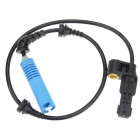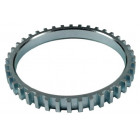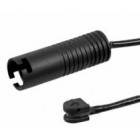ABS sensor & Brake wear indicator
The ABS sensors in your car are mounted on the wheels and measure how fast they're rotating. When you brake sharply, your wheels can lock up. If this happens, the wheel stops turning while your car is still moving. This can cause you to skid and lose steering control. The ABS system was invented to prevent this. ABS stands for Anti-lock Braking System. The ABS system consists of an ABS ring and an ABS sensor.
The ABS sensor measures how fast your wheels are turning by registering the teeth of the ABS ring. The ABS ring is mounted on your drive shaft. When the wheel rotates, the teeth pass by the sensor. The sensor detects each tooth. If the sensor notices that your wheels suddenly stop rotating and therefore no more teeth move past the sensor, the ABS system activates. The brakes are momentarily released.
The wheels start rotating again, allowing you to maintain steering control. The system alternately applies and releases the brakes. This simulates the "cadence braking" technique that many drivers have learned. This all happens in fractions of a second.
This is especially important on slippery roads, where grip is often an issue. A properly functioning ABS sensor is therefore extremely important, especially if you need to make an emergency stop in hazardous conditions.
The wear indicator is also a small but important part of the braking system. This indicator warns the driver when the brake pads are worn and need to be replaced urgently. The wear indicator is located on the brake pads, mounted under the brake lining.
When the brakes are sufficiently worn, the wear indicator contacts the brake disc. This sends a signal to your onboard computer, which displays a warning on your dashboard. This allows you to replace the pads on time and prevent brake problems.





